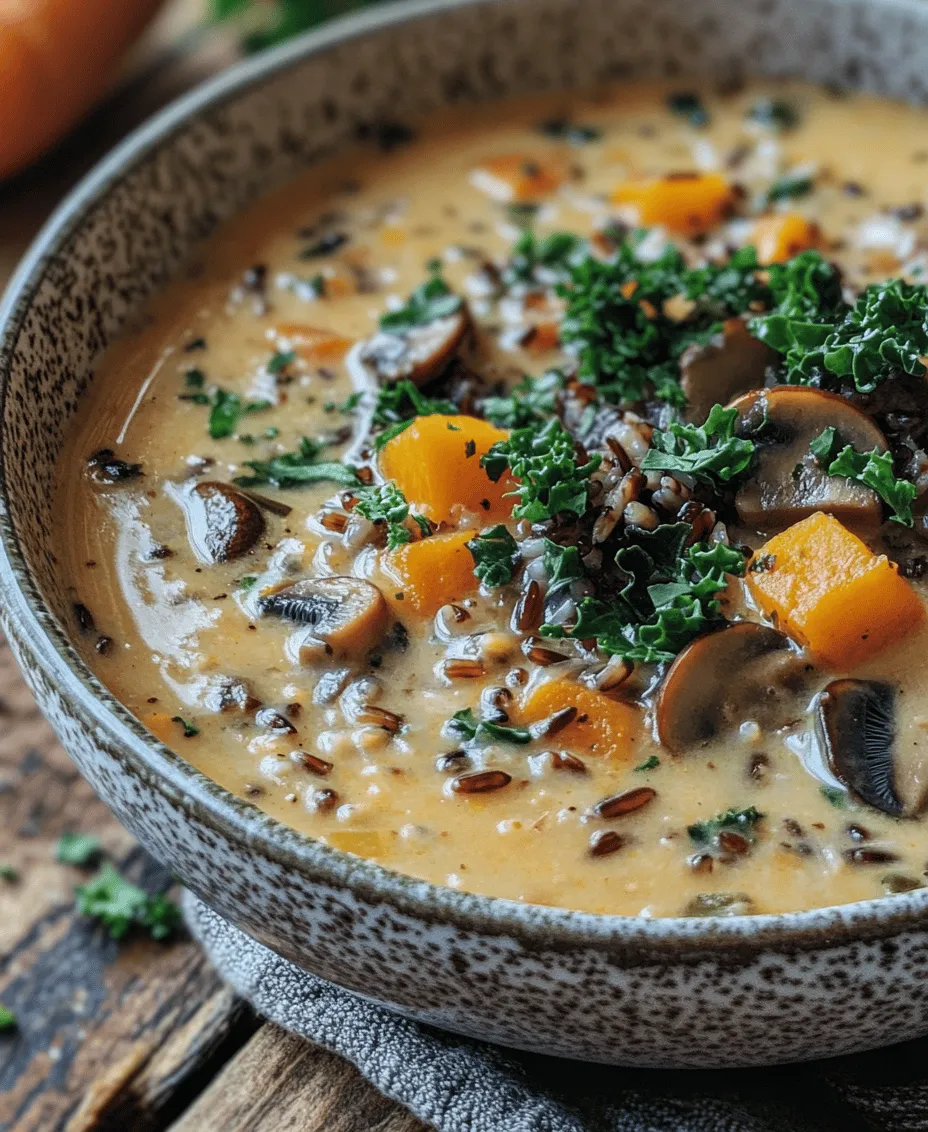Introduction
As the leaves begin to change and the air turns crisp, autumn beckons us to embrace the comforting flavors of the season. Seasonal cooking is not just about using ingredients that are fresh and locally sourced; it’s about capturing the essence of this delightful time of year. Autumn flavors—think earthy root vegetables, hearty grains, and aromatic herbs—bring warmth and coziness to our dinner tables, making every meal a celebration of nature’s bounty.
One standout ingredient often featured during this time is wild rice. Unlike traditional white or brown rice, wild rice is not actually rice at all; it’s a semi-aquatic grass native to North America. Known for its nutty flavor and chewy texture, wild rice elevates any dish, making it a perfect addition to soups. It’s more than just a delicious ingredient; it’s a nutritional powerhouse, full of protein, fiber, and essential nutrients. As the temperatures drop, there’s nothing quite as comforting as a bowl of warm soup that nourishes both the body and soul.
The Essence of Autumn in a Bowl
Imagine a bowl filled with a medley of vibrant colors and aromatic scents. Cozy Autumn Wild Rice Soup captures the spirit of the season with its rich, inviting flavors. The combination of wild rice with seasonal vegetables creates a symphony of tastes that warms from the inside out. Each spoonful is a celebration of autumn, crafted from ingredients that reflect the harvest and the changing landscape.
Soup has long held a significant place in autumn traditions across cultures. Whether it’s a hearty minestrone simmered in an Italian kitchen or a spiced pumpkin soup enjoyed during Thanksgiving, soups have a way of bringing people together. They are often at the heart of family gatherings, embodying warmth, comfort, and togetherness. As we gather around the table to share stories and laughter, a warm bowl of soup can enhance these cherished moments.
In addition to their comforting qualities, soups are an excellent way to incorporate seasonal vegetables. Root vegetables like carrots and parsnips, leafy greens like kale, and nutrient-dense squash not only add flavor but also provide a variety of health benefits. Consuming seasonal produce can help boost immunity, improve digestion, and contribute to overall well-being, making a cozy bowl of soup a smart choice for autumn nourishment.
Understanding Wild Rice
To truly appreciate Cozy Autumn Wild Rice Soup, we must delve into the unique characteristics of wild rice. This ancient grain has a rich history, originally harvested by Native American tribes who relied on it as a staple food source. Today, wild rice is celebrated for its distinct flavor profile and impressive nutritional benefits.
Nutritionally, wild rice stands out among other grains. It is higher in protein and fiber than most varieties of rice, making it a more filling option. It also contains a variety of essential vitamins and minerals, including magnesium, phosphorus, and B vitamins. Additionally, wild rice is a good source of antioxidants, which can help combat oxidative stress and promote overall health.
When compared to white or brown rice, wild rice offers a more complex flavor and a delightful chewy texture. It adds an earthy note to dishes that can’t be replicated by other grains. This unique quality makes wild rice an ideal choice for soups, where its texture can hold up against the broth and other ingredients, providing a satisfying bite.
Incorporating wild rice into your diet is simple and rewarding. Not only does it enhance the flavor and texture of your meals, but it also contributes to a balanced diet. As the cooler months approach, consider adding this nutritious grain to your weekly meal plan.
Ingredient Breakdown for Cozy Autumn Wild Rice Soup
Every great soup starts with quality ingredients. For Cozy Autumn Wild Rice Soup, we’ll focus on a blend of wholesome components that come together to create a nourishing and satisfying dish. Here’s a detailed breakdown of the key ingredients:
Wild Rice
Wild rice serves as the heart of this soup. Its nutty flavor and chewy texture create a delightful contrast to the creamy elements of the dish. When cooked, wild rice expands and develops a slight pop, making each bite a delicious experience. Look for whole grain wild rice for the best flavor and nutrition.
Olive Oil
The base for our soup begins with olive oil, which not only adds richness but also provides a healthy fat source. Extra virgin olive oil is rich in monounsaturated fats and antioxidants, making it a heart-healthy choice. It enhances the flavors of the vegetables while contributing to the overall mouthfeel of the soup.
Onions and Garlic
Onions and garlic form the aromatic foundation of many soups, including this cozy creation. Sautéing these two ingredients releases their natural sweetness and creates a fragrant base that sets the tone for the entire dish. Onions are a good source of vitamin C, B vitamins, and various antioxidants, while garlic is known for its immune-boosting properties.
Carrots and Celery
Adding carrots and celery not only provides sweetness and crunch but also contributes essential vitamins and minerals. Carrots are rich in beta-carotene, which our bodies convert into vitamin A, promoting healthy vision and skin. Celery, on the other hand, is low in calories and high in fiber, making it a great addition for those looking to maintain a balanced diet.
Butternut Squash
Butternut squash brings creaminess to the soup while adding a touch of natural sweetness. This vibrant orange vegetable is packed with vitamins A and C, potassium, and fiber. Its smooth texture blends beautifully with the other ingredients, enriching the overall flavor of the soup.
Herbs (Thyme and Rosemary)
Thyme and rosemary are the aromatic herbs that elevate the soup’s flavor profile. Fresh or dried thyme adds a subtle earthiness, while rosemary contributes a fragrant pine-like aroma. Both herbs are known for their anti-inflammatory properties and can enhance digestion, making them a perfect addition to a warming soup.
Vegetable Broth
The quality of your vegetable broth can make or break your soup. Opt for a homemade or low-sodium store-bought broth to control the flavor and salt levels. A good broth serves as the foundation for the soup, infusing each ingredient with depth and richness. It’s the liquid gold that ties the entire dish together.
Kale
Kale is often dubbed a superfood, and for good reason. This leafy green is packed with vitamins K, A, and C, along with minerals like calcium and iron. Adding kale to our soup not only boosts the nutritional profile but also adds a lovely texture and vibrant color. As the kale wilts in the hot broth, it becomes tender and melds perfectly with the other ingredients.
Mushrooms
Mushrooms, whether you choose cremini, shiitake, or button, add an umami flavor that deepens the soup’s profile. They’re also a great source of vitamins D and B, as well as selenium and antioxidants. The earthy taste of mushrooms complements the nuttiness of wild rice, creating a harmonious flavor experience that is both satisfying and nutritious.
With these carefully selected ingredients, Cozy Autumn Wild Rice Soup promises to be a nourishing, flavorful meal that captures the essence of the season. Each component plays a vital role, working together to create a dish that is not only delicious but also packed with health benefits. As we prepare to dive into the cooking process, let’s explore how to bring these ingredients together into a comforting bowl of soup.
Stay tuned for the next section, where we will detail the step-by-step instructions to create this delightful autumn dish!
Coconut Milk vs. Heavy Cream: Dietary Variations and Richness
When it comes to adding creaminess to your Cozy Autumn Wild Rice Soup, the choice between coconut milk and heavy cream can significantly impact the dish’s flavor and nutritional profile. Coconut milk provides a rich, tropical taste, making it an excellent dairy-free option that aligns well with vegan or lactose-intolerant diets. It is also lower in calories than heavy cream and adds healthy fats, specifically medium-chain triglycerides (MCTs), which are known for their energy-boosting properties.
On the other hand, heavy cream lends a luxurious richness and velvety texture that some might find irresistible. It enhances the soup’s mouthfeel and provides a depth of flavor that complements the earthiness of the wild rice. For those looking to indulge, heavy cream is a classic choice that elevates the dish to a whole new level of comfort. Ultimately, the decision depends on your dietary preferences and the flavor profile you wish to achieve.
Fresh Parsley: A Touch of Color and Freshness
Adding fresh parsley to your Cozy Autumn Wild Rice Soup not only enhances its visual appeal but also contributes a burst of freshness that complements the rich flavors. Parsley is a versatile herb that adds brightness to the dish and is packed with vitamins A, C, and K. Its vibrant green color serves as a beautiful contrast against the hearty tones of the soup, making it more inviting. Sprinkle chopped parsley on top just before serving for an extra pop of color and a hint of herbal flavor that balances the richness of the soup.
Step-by-Step Preparation of Cozy Autumn Wild Rice Soup
1. Gather Your Ingredients
Before you begin, ensure that you have all the necessary ingredients within reach. This organization will help streamline the cooking process and make it more enjoyable.
2. Sautéing the Base for Flavor Development
Start by heating 2 tablespoons of olive oil or butter in a large pot over medium heat. Once the oil is shimmering or the butter is melted, add the diced onion, carrots, and celery (often referred to as mirepoix). Sauté these vegetables for about 5-7 minutes, or until they become tender and fragrant. The goal is to develop a flavorful base that will enhance your soup.
3. Proper Vegetable Cooking Methods for Texture
Next, add minced garlic and chopped mushrooms to the pot. Sauté for an additional 3-4 minutes until the mushrooms release their moisture and become golden brown. This step is essential as it not only adds depth to the soup but also ensures the vegetables maintain a pleasant texture.
4. Importance of Incorporating Spices at the Right Time
Once your vegetables are well-cooked, it’s time to add the spices. Stir in 1 teaspoon of dried thyme, 1 teaspoon of dried rosemary, and a pinch of salt and pepper. Allow the spices to toast for about 1 minute; this technique releases their natural oils and enhances their flavors, making your soup more aromatic.
5. Cooking Wild Rice to Perfection: Timing and Water Ratios
Next, it’s time to add the wild rice. Rinse 1 cup of wild rice under cold water to remove any excess starch, then add it to the pot along with 6 cups of vegetable broth (or chicken broth for a non-vegetarian option). Bring the mixture to a gentle boil, then reduce the heat to low, cover, and let it simmer for about 45-50 minutes. Wild rice takes longer to cook than regular rice, so be patient; the texture should be chewy yet tender.
6. Finalizing the Soup with Creaminess and Seasoning
Once the wild rice is cooked, stir in 1 can (13.5 oz) of coconut milk or 1 cup of heavy cream, depending on your choice. This will add the creamy texture and richness that makes the soup comforting. Taste and adjust the seasoning with more salt, pepper, or herbs as needed. If the soup is too thick, you can add more broth or water until you reach your desired consistency.
Cooking Tips for the Perfect Soup
– Importance of Simmering Times for Flavor Development: Allow the soup to simmer gently after adding the cream or coconut milk. This extra time helps the flavors meld together and intensify, resulting in a more harmonious dish.
– Adjusting Seasonings to Individual Taste Preferences: Don’t be afraid to experiment with herbs and spices! Each person’s palate is different, so taste the soup as you go and adjust the seasonings according to your preferences. You might find that a dash of cayenne pepper or a squeeze of lemon juice can elevate the dish even further.
– Tips for Achieving the Right Consistency: The ideal soup should be creamy but not overly thick. If you find your soup is too thick, gradually add more broth or water until you achieve your desired consistency. Conversely, if it’s too thin, let it simmer uncovered for a while to allow some of the liquid to evaporate.
Serving Suggestions and Pairings
When it comes to serving your Cozy Autumn Wild Rice Soup, presentation is key. Ladle the soup into bowls and top with a sprinkle of fresh parsley for that burst of color and freshness. Pair this hearty soup with crusty bread, such as a rustic sourdough or a warm baguette, perfect for dipping. A simple side salad with mixed greens and a light vinaigrette can also complement the richness of the soup, adding a refreshing contrast.
This soup is ideal for various occasions, from family gatherings to cozy nights in. It’s the perfect dish to serve on a chilly autumn evening, providing warmth and comfort to everyone at the table. Additionally, it makes for excellent leftovers, so don’t hesitate to make a larger batch to enjoy throughout the week.
Nutritional Information
This Cozy Autumn Wild Rice Soup is not only delicious but also packed with nutrients. Here’s a breakdown of the nutritional values per serving (based on 8 servings):
– Calories: 250
– Protein: 6 grams
– Carbohydrates: 35 grams
– Dietary Fiber: 4 grams
– Fat: 10 grams
– Vitamins: A, C, and K from the vegetables, along with several B vitamins from the wild rice.
The primary ingredients in this soup offer numerous health benefits. Wild rice is high in antioxidants and provides essential amino acids, while the vegetables contribute vitamins and minerals that support overall health. Additionally, using coconut milk or heavy cream provides healthy fats that can promote satiety.
This soup fits well into a balanced diet, as it includes whole grains, vegetables, and healthy fats. It can serve as a satisfying meal on its own or be paired with a protein source for a more rounded dish.
Conclusion
In summary, the Cozy Autumn Wild Rice Soup is a celebration of seasonal flavors, combining the earthiness of wild rice with the warmth of autumn vegetables and the creaminess of coconut milk or heavy cream. This dish embodies comfort and nourishment, making it a perfect addition to your fall repertoire.
As you embrace the flavors of autumn, consider making this soup a part of your cooking routine. It’s not just a meal; it’s a way to create lasting memories with loved ones. The joy of cooking and sharing seasonal dishes is a delightful experience that warms the heart as much as it does the belly. So gather your ingredients, follow the steps, and let the comforting aroma of this soup fill your kitchen, inviting everyone to join in for a cozy meal.



